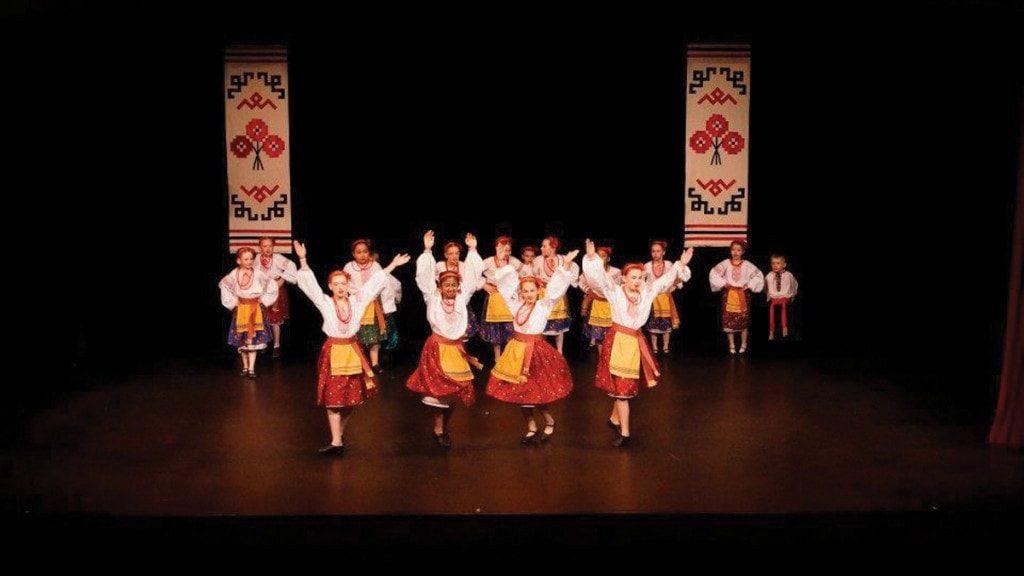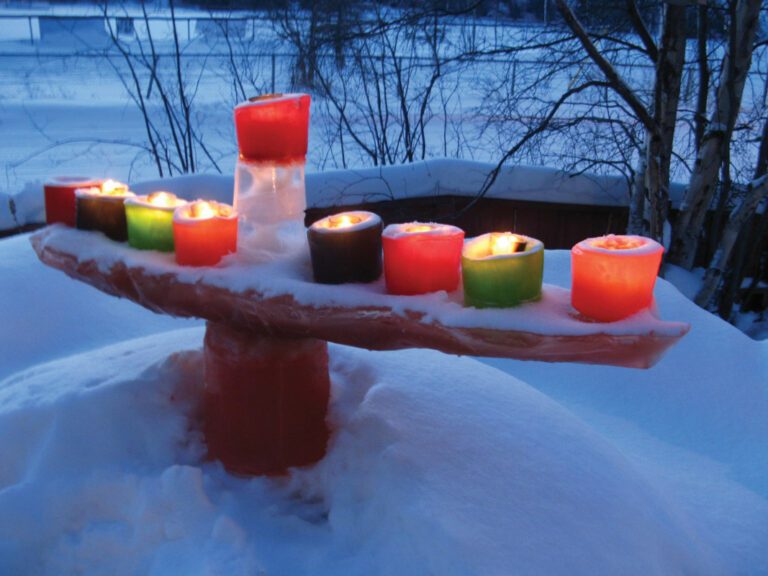The many ways Yellowknifers celebrate the season
Yellowknife has slid into the darkest and coldest months of the calendar – but ironically, the city’s multicultural celebrations transform winter into a season of warmth and light!
Here’s a sampling of how people in Yellowknife celebrate during the festive season.
Yellowknives Dene Traditional Celebrations
Christmas and New Year’s Day celebrations in N’Dilo and Dettah have changed over the years, but still include a community feast and drum dance, says Mary-Rose Sundberg, Executive Director of the Goyatikö Language Society.
When she was young, she says everyone would attend church on Christmas Eve and the children would be “so excited” to wear the new jackets, mittens, moccasins and/or mukluks their parents had made them for Christmas. After church service on Christmas morning, there would be a potluck feast and drum dance later in the day. “Everyone would bring whatever they had, whether it was fish or caribou, moose meat, rice pudding or tea,” says Sundberg.
Now, most people spend Christmas with their families and the largest feast and drum dance of the year are saved for New Year’s Day in the new community hall in Dettah. Before the Dettah Drummers kick off that big celebration, there’s church in the morning, then early in the afternoon people take an hour or so to walk house-to-house and shake hands. It is also tradition for the homeowners to greet their visitors with a very short speech expressing their gratitude for the year past – and the year to come.
Ukrainian Malanka Celebration
Yellowknifers of Ukrainian heritage (and many who are not) have gathered for more than 30 years to celebrate the Ukrainian New Year’s Eve. The celebration is known as Malanka, which means rebirth or regeneration, and is held the closest Saturday to January 13th. It’s a traditional welcome to a New Year and spring – with food, music, polkas and waltzes, says DonnaMarie Ouellette, who teaches the Aurora Ukrainian Dancers.
For Ouellette, the highlight of Malanka is watching her dancers, especially the children, “show off their stuff” after months of hard work and practice. But she also appreciates that the multicultural population of Yellowknife braves the cold each year to see how another culture celebrates.
Delicious food is another highlight, with “full Ukrainian fare,” says Ouellette, including favourites such as Pyrohy (perogies), Kubasa (garlic sausage), Holubsti (cabbage rolls), Nalysnyky (crepes), Kutya (a first course dish of wheat, honey and poppy seed) and more.

Aurora Ukrainian Dancers celebrate Malanka. | photo courtesy Lee Sacrey
Newfoundland Mummers in Yellowknife
Most Yellowknifers would probably be alarmed by the arrival of a dozen or more masked people at their door, but for Newfoundlanders, it’s a much-loved part of their heritage.
Mummering is an old Christmas tradition from England brought to Newfoundland sometime in the early 19th century – and onward to Yellowknife with the many men and women who have moved here seeking work.
Yvonne Fleming, who moved to Yellowknife from Newfoundland with her husband Dennis more than 20 years ago, says mummering is when a group of friends gather at a house and put on costumes to disguise their identity: masks or pillow cases over their heads, grandma’s old dress or a pair of full-length long johns, and plenty of stuffing with pillows. The mummers arrive unexpected (and often carrying guitars and accordions), knocking hard on the door and shouting, “Any mummers allowed in?”
They proceed to dance about the host family’s living room and sing the Mummer’s Song – while the hosts try to guess their identities. Of course, Newfoundland hospitality requires that the hosts provide their guests with refreshments! Once the mummers are unveiled, the hosts dress up in costume and join the mummers troupe as they move on to another home – or everyone stays put and the evening turns into a “full-blown Newfoundland kitchen party,” says Fleming.
Muslim Festival of the Sacrifice
There are no religious holidays for Muslims in the depth of winter this year, but Muslims did celebrate the Festival of the Sacrifice October 15-18, says Yousry Abdelmegid, who is a member of the Muslim community in Yellowknife.
The Festival of the Sacrifice is the biggest holiday of the year for Muslims and honours the willingness of Abraham to sacrifice his son as commanded by Allah, and that Allah provided Abraham with a lamb to sacrifice instead. It also marks the end of the annual pilgrimage to Mecca.
Muslims observe the Festival of the Sacrifice by fasting for the day before the holiday. The holiday begins with prayers at the mosque on the first morning, followed by family and friends visiting and gathering for a meal that includes a sacrificed sheep (usually provided by a butcher shop in Alberta) that is also shared with people in need.
Since the dates of the religious holidays are set in the lunar Islamic calendar, they vary in the Gregorian calendar, moving about 11 days earlier each year. Abdelmegid recalls that in 2006 the Festival of the Sacrifice began during the Christmas holidays. “That was one of the best holidays ever because we were celebrating at the same time as the rest of the community.”
Vietnamese New Year in Yellowknife
Tet Nguyen Dan, or Tet for short, is the Vietnamese New Year – the country’s biggest and most popular festival. The celebrations begin on the first day of the first month in the lunar calendar, which this year will fall on January 31.
Tet is also the most important celebration for about 200 people from Vietnam who now call Yellowknife home, says Tung Tram, who moved here from Vietnam more than 30 years ago.
Back in Vietnam, Tet celebrations can last up to seven days as people return to their home communities to visit with family, friends and neighbours, and go to the temple. Since such a lengthy celebration isn’t possible here, the Yellowknife Vietnamese Association organizes a one-day event that gives people a chance to celebrate the New Year, and helps ensure their cultural traditions continue into the next generation.
“People get together, they prepare a lot of food and celebrate, and we hand out the Red Envelopes of lucky money to the children and elders so that they have a happy new year,” says Tram.
Tram says the best part of Tet is hearing the elders say how much they enjoy the gathering and the opportunity to visit with old friends.
Northern Hanukkah with Ice Menorah
At sundown on November 27th, members of the small Jewish community in Yellowknife began celebrating Hanukkah, the Jewish festival of rededication, also known as the festival of lights.
Hannukah is an eight-day festival commemorating the rededication of the Holy Temple (the Second Temple) in Jerusalem at the time of the Maccabean Revolt against the Greeks in the 2nd century BC. At the time of rededication, oil was needed for the Temple menorah, which was supposed to burn throughout the night every night. There was only enough oil to burn for one day, yet miraculously, it burned for eight days.
For Miki Ehrlich and her family, Hanukkah begins with her husband Alan lighting the ice Menorah the family creates in their yard. A Hanukkah menorah holds nine candles: one for each night, plus a shammus (helper) candle – although lighting the candles can be challenging when the temperature hovers below -30 C and/or strong winds are blowing.
The Ehrlich family also hosts a Hanukkah party. Activities include playing a children’s game with a dreidel – a four-sided spinning top, that helps them learn a little Hebrew and win some chocolate coins – singing songs, and eating fried foods such as potato latkahs (pancakes) and jelly doughnuts.
“Hanukkah shares some themes with other festivals that occur at this time of year. Celebrating the holiday brings family and friends together, and the focus on light and hope is really positive when it is dark and cold out,” says Ehrlich.
So, be of good cheer Yellowknifers. Spring and the sun will eventually return – and until then you can bask in the warmth of the city’s multicultural celebrations!







